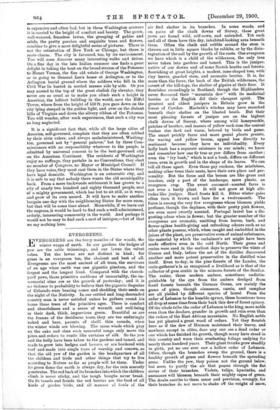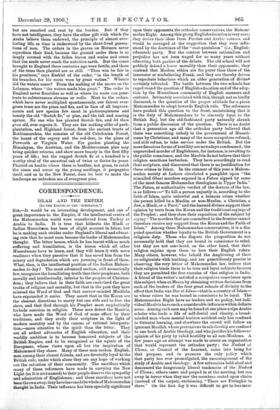EVERGREENS.
EVERGREENS are the furry mantles of the woods, the winter wraps of earth. In our gardens the hedges of yew are the sable trimmings, and our lawns the velvet robes. Yet the lawns are not distinct in kind ; for grass is an evergreen too, the choicest and best of all. Evergreens are the most ancient of all trees, the survivors of an age when earth was one gigantic pinetum, and the largest and the longest lived. Compared with the church- yard yews, those primitive emblems of immortality, the im- memorial elms are as the growth of yesterday; and it is no violence to probability to believe that the gigantic Sequoias of Colorado were bearing cones and shedding their seeds on the night of the Nativity. In our settled and long-descended country man is never satisfied unless he gathers round his home these trees of the primitive ages. There is comfort and cheerfulness and a sense of warmth and well-being in their dark, thick, impervious green. Beautiful as are the frames of the deciduous. trees, they are too enduringly naked and bare, parents of. shrill thin. sounds, when the winter winds are blowing. The same winds which play on the oaks and elms such mournful songs only move the pines and cedars to rustle like curtains of silk. So the yew and the holly have been taken to the gardens and tamed, and made to grow into hedges and bowers, or are bordered with turf and made into single trees of worship and renown, so that the old yew of the garden is the headquarters of all the children and birds and other things that try to live according to Nature so far as people will let them. Under its green dome the earth is always dry, for the rain scarcely penetrates. The red bark of its branches into which the children climb is never sticky, and the tough boughs never break. On its tassels and fronds the red berries are the food of all kinds of garden birds, and all manner of fowls of the air find shelter in its branches. In some woods, and on parts of the chalk downs of Surrey, these great yews are found wild, self-sown, and untended. Yet each and all of them have this dry, inhabited-looking area 'beneath them. Often the chalk and rubble around the stern is thrown out in little square blocks by rabbits, or by the disin- tegration of the soil by the growth of the roots. One evergreen we have which is a child of the wilderness, the only tree never taken into gardens and tamed. This is the juniper, native of our downs and of some Scotch heaths and forests, flourishing at great heights, a modest, cone-shaped tree, with tiny leaves, gnarled stem, and aromatic berries. It is, far more than the furze, the bush of the British wilderness, the covert Of the hill-tops, the shelter of gipsies rat their fires. It • flourishes exceedingly in Scotland, though the Highlanders never flavoured their "mountain dew" with its medicinal berries as • the English did their cheapest spirit. The greatest and oldest junipers in Britain grow in the forest of Cawdor. Macbeth's witches may have crouched beneath their shelter on the blasted heath. But their most pleasing forests of juniper are on the highest chalk downs of Surrey, where among wild honeysuckle, patches of heather, and masses of yellow rock-rose the conical bushes rise dark and warm, beloved by birds and game. The smart prickly furze and more genial plank genisui, the waving and yellow broom, appeal less directly to sentiment because they have no individuality. Every holly bush has a separate existence in our minds; we know and remember how one fir tree or yew differs from another ;. even the "ivy bush," which is not a bush, differs on different trees, even in growth and in the shape of its. leaves. We can tell all these apart. Even those gay cuckoos, the mistletoes, Tasking other trees their nests, have their own place and per- sonality. But the furze and the broom are like grass and bracken, only a part of the landscape, mere plants, an evergreen crop. The sweet cocoanut - scented furze is not even a hardy plant. It will not grow at high alti- tudes like juniper. Hard frosts kill it. Bitter winter gales often turn it brown and bare for a twelvemonth. The furze is among the very few evergreens whose blossom yields perfume, though the daphnes, with their pretty pink flowers, are even more sweetly scented. Portugal laurel has a dis- gusting odour when in flower; but the greater number of the evergreens are aromatic, emitting from leaves, bark, and flower-spikes health-giving and refreshing odours such as no other plants possess, which, when caught and embedded lathe juices of the plant, are preservative even of animal substances, the material by which the embalmer's art might have been made effective even in the cold North. Their gums and resins were used in the earliest days to preserve the wines of Greece and Italy, before the art of the distiller discovered another and more potent preservative in the distilled wine itself. Even to-day, in the pine forests of the Landes, the resin-gatherer's is as recognised a livelihood as is that of the collector of gum arabic in the mimosa forests of the Soudan. The resins, those modern ambers, sometimes undistin- guishable by the eye from the ambers dredged from fossil forests beneath the German Ocean, are mainly the gams of pines, though cinnamon, cassia, and camphor are all yielded by different species of laurel. From the cedar of Lebanon to the humble spruce, these bounteous trees all drop at some time from their bark this dew of forest spicery. Of the whole tribe the cedar of Lebanon is the king, more noble even than the deodars, grander in growth and ruin even than the cedars of the East African mountains. No English noble has yet planted a great wood of cedars. Yet they flourish here as if the dew of Hermon moistened their leaves, and nowhere, except in cities, does any one see a dead cedar or one which has finished its growth, though many have stood in this country and worn their everlasting foliage undying for nearly three hundred years. Their giant trunks grow steadily in girth, yet no one ever saw a hollow cedar of Lebanon. Often, though the branches sweep the ground, there is a healthy growth of grass and flowers beneath the spreading arms. Unlike the yew, they poison not the ground below; but seem to purify the air that passes through the flat sieves of their branches. Violets, tulips, hyacinths, and anemones will blossom beneath their mighty capes of green. The Arabs ascribe to them sense and prevision, wrongly, for their branches do not move to shake off the weight of snow, bid are smashed and rent by the burden. But if they have not intelligence, they have the other gift with which the Arabs believe them endowed, the principle of almost ever- lasting life, as time is Understood by the short-lived genera- tions of men. The cedars in the groves on Hermon never reproduce their kind, because the ground under them is so deeply covered with the fallen leaves and scales and cones that the seeds never reach the nutritive earth. But the cones brought to England three centuries ago were fertile, and those of the trees then planted are so still. "Thus was he fair in his greatness," says Ezekiel of the cedar, "in the length of his branches, for his roots were by great waters." Whence did the waters come? From the melting of the snows on the Lebanon, where "the waters made him great." The cedar in England never fionrishes so well as where its roots can pene- trate to subterranean streams or wells. Next to the cedars, which have never multiplied spontaneously, our fairest ever- green trees are the pines and firs, and in face of all improve- ments and new species few excel in picturesqueness and beauty the old "Scotch fir," or pine, and the tall and soaring spruce. No one who has planted Scotch firs, and let them grow old, ever regrets it. They are the making alike of park, plantation, and Highland forest, from the ancient tracts of Rothiemurchus, the remains of the old Caledonian Forest, the haunt of the osprey and the red-deer, to the pines of Petworth or Virginia Water. For garden planting the Himalayan, the Austrian, and the Mediterranean pine may bring quicker returns, and show more beauty in the first fifty years of life ; but the rugged Scotch fir at a hundred is a worthy rival of the ancestral oak of twice or thrice its years. Planted on heaths where there is heather, not grass, to catch the -cones and nurse up the young seedlings, it propagates itself, and as in the New Forest, does its best to make the landscape an unbroken sea of evergreen pine.



































 Previous page
Previous page